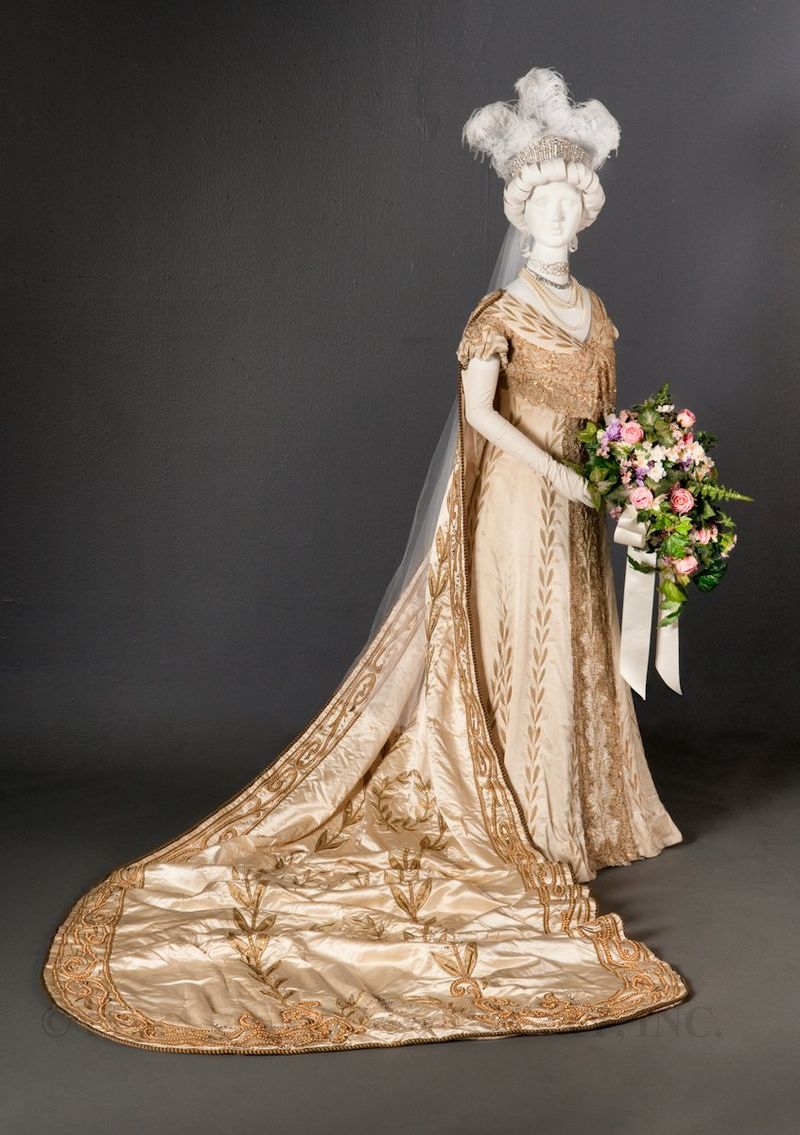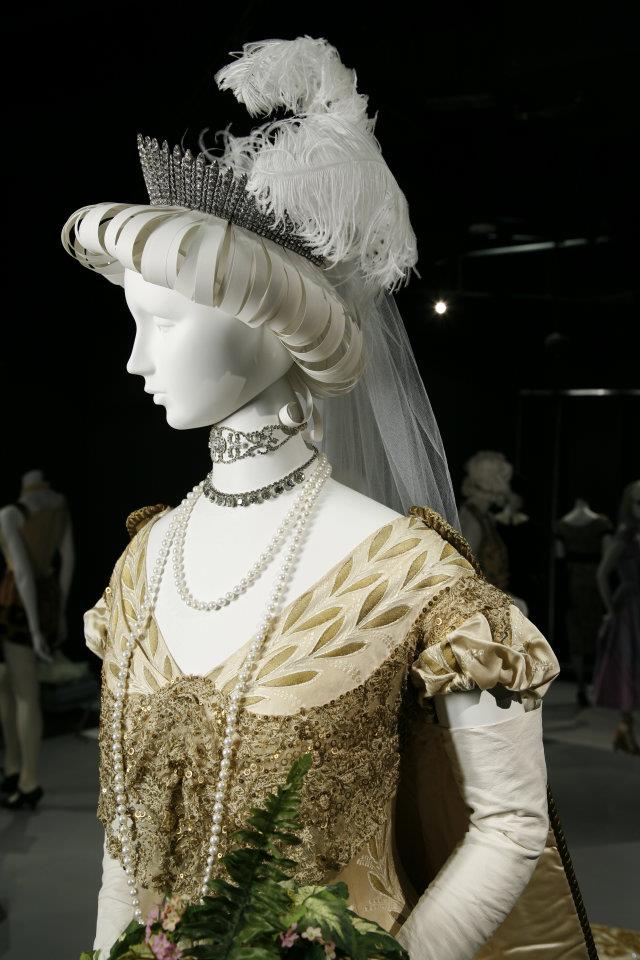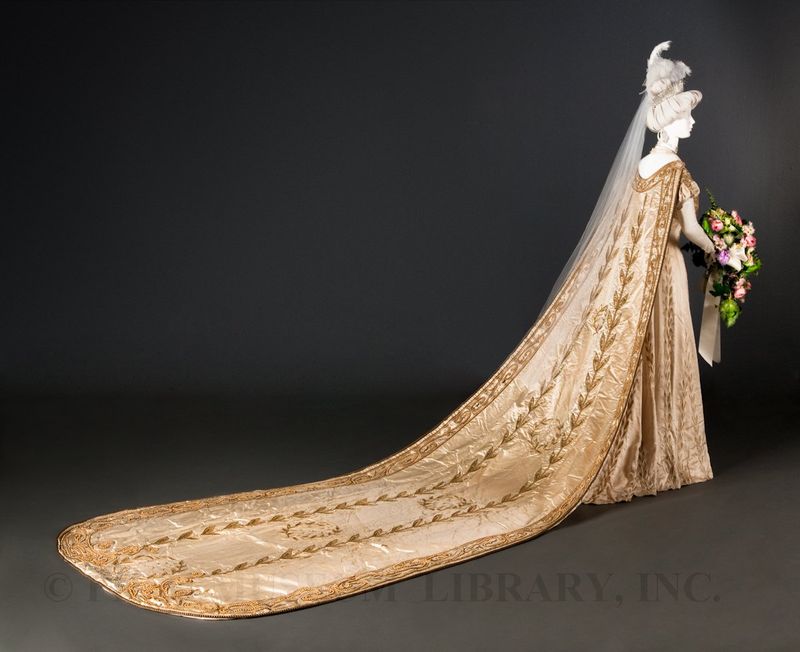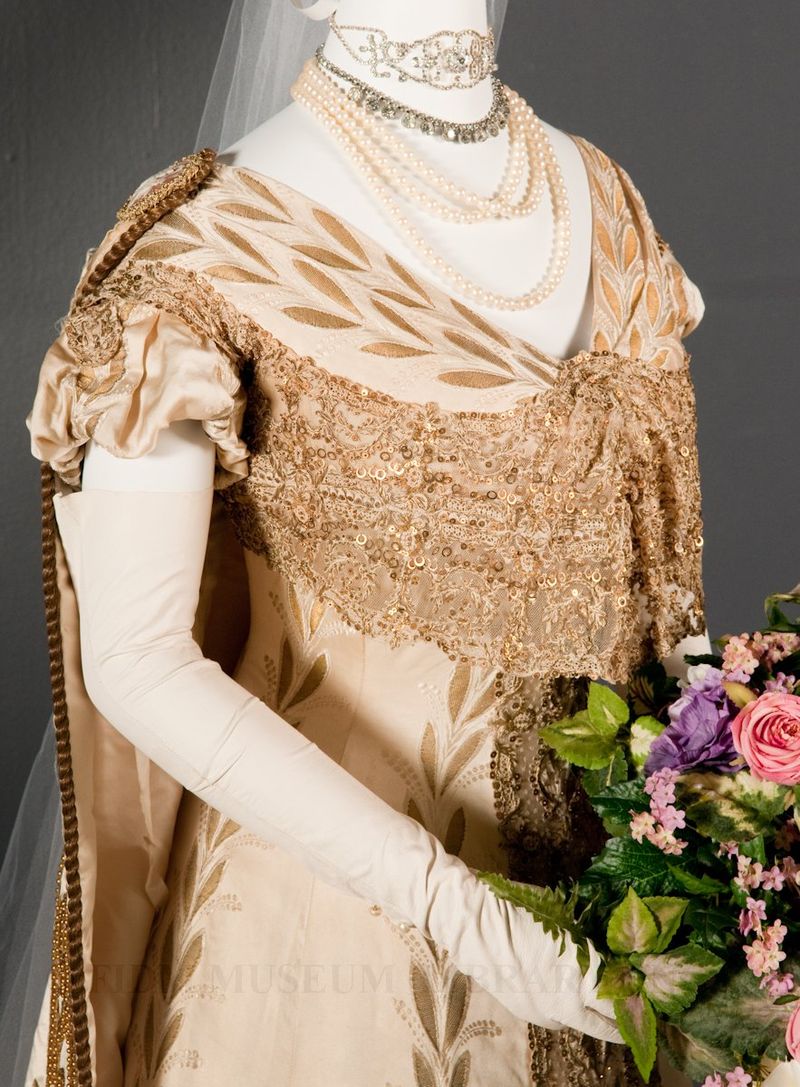Ladies attending Their Majesties' Courts will appear in Full Dress, with Trains and Plumes.1
 Court gown & train
Court gown & train
London, England
Redfern
1907
Museum Purchase, Funds provided by Yvonne Hummel
2008.932.19AB
Worn only during the ceremony in which selected individuals were introduced to the King and Queen, court dress was an elegant, highly regulated uniform. Adhering to the spoken and unspoken regulations governing court dress was almost as important as having the "correct" background. Each European court had its own version of court dress, which was more or less elaborate depending on the wealth of the particular court. The court gown and train pictured above are both on display in FABULOUS!, our current exhibition.
We are fortunate to know the provenance of this court gown. It was worn by American Ann Bloomfield Gamble Post during her 1907 presentation to King Edward VII and Queen Alexandra of the United Kingdom. Edward was a popular leader; his accession to the throne in 1901 transformed the somber court of his mother Queen Victoria into "an exceptionally brilliant spectacle."1 Alexandra exerted a major influence on fashion. Presentation at their court was a eagerly anticipated social privilege.
To be presented at court, a woman had to be sponsored by another woman (often a mother, mother-in-law or other relative) who had already been presented at court. During Edward and Alexandra's reign, American women presented at court were always sponsored by the wife of the American ambassador. In her application, the sponsor vouched for the character of the presentee, ensuring that only women of good character were presented. Under no circumstances could a woman who wanted to be presented make an application for herself. All applicants were investigated before being accepted for presentation. Women eligible for presentation included wives and daughters of the aristocracy, clergy, navy or military officers and certain "aristocratic" professions, including physicians and barristers. Ineligible women included divorcees who were considered legally at fault for the divorce, and actresses.
The actual presentation itself was a brief affair. After waiting her turn, the presentee and her sponsor were announced by name and entered the throne room. Approaching the King and Queen, the presentee stopped to curtsy in front of each sovereign. The manner of the curtsy was of great importance and women who didn't curtsy correctly to both the King and Queen were criticized by those in attendance. The presentee then stepped to the side, and backed gracefully away from the King and Queen. Pages were meant to help each women with her train as she backed out of the room, but according to a 1908 account they liked to tease the presentees by sometimes throwing a woman's train over her head.3 It is hard to imagine such silliness taking place in front of the King and Queen, but perhaps they were so absorbed in curtsy-watching that they didn't notice.
At the time of her presentation, Ann Bloomfield Gamble Post was married to American author Melville Davisson Post. Though we don't know all the details regarding Post's presentation at court, we do know who made her court gown: Redfern. Active between 1847-1940, Redfern's reputation was founded on stylish daywear, including tailormade suits and sporting dress for women. In the 1890s, Redfern expanded into evening wear, ball gowns and court dress. Initially based in London, Redfern also operated branches in Paris and New York.
Required elements of court dress included short sleeves, low-cut bodice, lengthy train and accessories including plumes, gloves and veil. Though white was not absolutely required, it was considered the most suitable color for both married and unmarried women. If in mourning, it was acceptable to wear mourning colors, such as black and white, gray or mauve. For women who "from illness, infirmity, or advancing age" could not wear the low-cut bodice, it was possible to obtain a dispensation and wear a higher bodice and longer sleeves.4 The number and color of plumes was also regulated: three for married women, two for unmarried. Plumes were always worn with a white veil or lace lappets. White kidskin gloves were a necessity, though women could choose whether to carry flowers or a fan.
 2008.932.19AB Ann Bloomfield Gamble Post's court gown as seen in FABULOUS!
2008.932.19AB Ann Bloomfield Gamble Post's court gown as seen in FABULOUS!
The train on our court dress is the required 11 feet, and attaches at the shoulders with hand-carved cameos depicting classical dancers. The classical theme is continued in the graduated laurel leaves decorating the train. Vertical lines of laurel leaves accent the princess seams of the gown, a silhouette named for Queen Alexandra when she was the Princess of Wales.

2008.932.19AB Fully extended, the train is 11 feet long!
1 Trendell, Herbert A.P., ed. Dress Worn at His Majesty's Court. (London: Harrison & Sons, 1908), 105.
2 Quoted in Arch, Nigel and Joanna Marschner. Spendour at Court: Dressing for Royal Occasions Since 1770. (London: Unwin Hyman, 1987), 100.
3 "When Women Are Presented At Court." The New York Times March 21, 1909.
4 Trendell, 107.



Gorgeous!
How to curtsey at a court presentation explained in this blog post: http://edwardianpromenade.com/etiquette/how-to-curtsey-at-a-court-presentation/.
You mean they don’t just let you in there in your mom jeans?!! What?! This is beautiful…I love the laurel leaves.